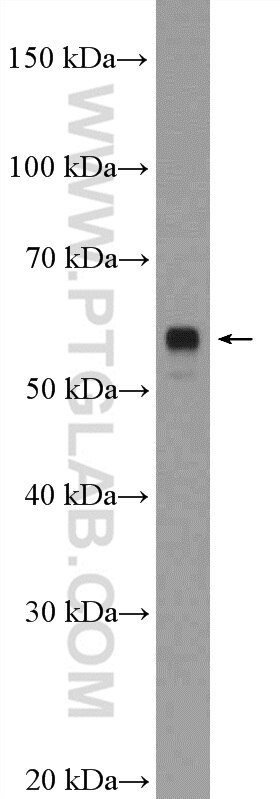LRRTM2 Polyklonaler Antikörper
LRRTM2 Polyklonal Antikörper für WB,ELISA
Wirt / Isotyp
Kaninchen / IgG
Getestete Reaktivität
human, Maus
Anwendung
WB, IP
Konjugation
Unkonjugiert
Kat-Nr. : 23094-1-AP
Synonyme
Galerie der Validierungsdaten
Geprüfte Anwendungen
| Erfolgreiche Detektion in WB | Maus-Rückenmarkgewebe |
Empfohlene Verdünnung
| Anwendung | Verdünnung |
|---|---|
| Western Blot (WB) | WB : 1:500-1:1000 |
| It is recommended that this reagent should be titrated in each testing system to obtain optimal results. | |
| Sample-dependent, check data in validation data gallery | |
Veröffentlichte Anwendungen
| IP | See 1 publications below |
Produktinformation
23094-1-AP bindet in WB, IP LRRTM2 und zeigt Reaktivität mit human, Maus
| Getestete Reaktivität | human, Maus |
| In Publikationen genannte Reaktivität | human |
| Wirt / Isotyp | Kaninchen / IgG |
| Klonalität | Polyklonal |
| Typ | Antikörper |
| Immunogen | LRRTM2 fusion protein Ag19422 |
| Vollständiger Name | leucine rich repeat transmembrane neuronal 2 |
| Berechnetes Molekulargewicht | 516 aa, 59 kDa |
| Beobachtetes Molekulargewicht | 59 kDa |
| GenBank-Zugangsnummer | BC126408 |
| Gene symbol | LRRTM2 |
| Gene ID (NCBI) | 26045 |
| Konjugation | Unkonjugiert |
| Form | Liquid |
| Reinigungsmethode | Antigen-affinitätsgereinigt |
| Lagerungspuffer | PBS mit 0.02% Natriumazid und 50% Glycerin pH 7.3. |
| Lagerungsbedingungen | Bei -20°C lagern. Nach dem Versand ein Jahr lang stabil Aliquotieren ist bei -20oC Lagerung nicht notwendig. 20ul Größen enthalten 0,1% BSA. |
Hintergrundinformationen
Leucine-rich repeat transmembrane proteins (LRRTMs) are synaptic cell adhesion molecules. LRRTMs are highly localized in the postsynaptic density and play various roles in the formation, maturation, and function of synapses (PMID: 25951919). LRRTM2 acts as a post-synaptic ligand of Neurexins. LRRTM2 regulates excitatory synapse development and function in the vertebrate nervous system (PMID: 20064387).
Protokolle
| Produktspezifische Protokolle | |
|---|---|
| WB protocol for LRRTM2 antibody 23094-1-AP | Protokoll herunterladen |
| Standard-Protokolle | |
|---|---|
| Klicken Sie hier, um unsere Standardprotokolle anzuzeigen |
Publikationen
| Species | Application | Title |
|---|---|---|
Elife The molecular appearance of native TRPM7 channel complexes identified by high-resolution proteomics |


